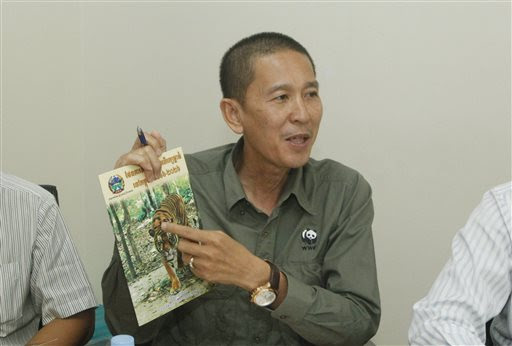
Chhith Sam Ath, Cambodia Director of World Wildlife Fund, WWF, shows a booklet during a press conference, in Phnom Penh, Cambodia, Wednesday, April 6, 2016. Cambodia has unveiled a plan to reintroduce tigers from abroad into the dry forests of the country, where they have become virtually extinct due to poaching. AP
PHNOM PENH, Cambodia — Cambodia has unveiled a plan to reintroduce tigers from abroad into the dry forests of the country, where the big cat has become virtually extinct thanks to poaching, conservation officials said Wednesday.
Between 20 and 50 tigers were believed to exist in Cambodia’s forests, but years of illegal poaching — of the tigers as well as their prey — led to a dramatic decline in their population. The last tiger spotted in Cambodia was seen in 2007 by camera trap — a hidden camera that is remotely triggered by the movement of animals — in the forests of eastern Mondulkiri province, the WWF conservation group said in a statement.
“Today, there are no longer any breeding populations of tigers left in Cambodia, and they are therefore considered functionally extinct,” it said.
The statement was released at a joint news conference by representatives of the government, WWF and the Wildlife Alliance, another conservation group.
Keo Omaliss, a government official in charge of wildlife, said Cambodia is considering negotiating with the governments of India, Malaysia, and Thailand to bring at least seven to eight tigers to live in the protected forests of Mondulkiri so they can breed and repopulate the forests.
“This would be the world’s first transnational tiger reintroduction and will be based on best practices developed from successful tiger reintroductions within India,” the WWF statement said. The plan was approved by Cambodia’s government on March 23.
The plan is to bring in the tigers after two years because Cambodia needs to resolve related issues such as poaching and rebuilding the population of tiger prey, which will be needed to sustain a tiger population, said Chhit Sam Ath, the director of WWF-Cambodia.
He said the arrival of the tigers could be pushed back to 2018 if the preservation efforts are not completed by 2017.
“Tigers are an iconic species and part of our natural heritage,” he said. “To bring tigers back to Cambodia would be the biggest conversation feat of its kind and would support the conversation efforts of the whole landscape.”
The entire plan will cost $20-50 million, which will come from donor countries.
After the Khmer Rouge’s brutal rule in the 1970s left Cambodia devastated, poor rural dwellers scoured the forests for wildlife. Much of what was found was sold to traders connected to China, where many wild animals, including tigers, are believed to possess medical and sex-enhancing properties.
Tigers have been classified as nearly extinct species worldwide. There are about 3,200 tigers in only 13 countries globally, according to WWF.